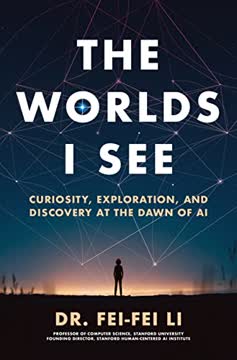Key Takeaways
1. The brain's unconscious system creates our perception of reality
"Our visual system doesn't just display patterns of light. It constructs an interpretation based on billions of neuronal calculations."
Unconscious processing. The brain actively interprets sensory input rather than passively receiving it. This unconscious system fills in gaps, anticipates patterns, and creates a coherent narrative of our experiences. For example, in optical illusions like the Kanizsa Triangle, we perceive shapes that aren't actually there.
Sensory integration. Our perceptions are the result of multiple sensory inputs being combined and interpreted. This is evident in phenomena like the McGurk effect, where visual information about lip movements can override auditory information, changing what we hear. Even in blind individuals, the brain adapts by enhancing other senses to create a mental map of the world.
- Examples of unconscious processing:
- Filling in the blind spot in our visual field
- Automatically correcting for color constancy under different lighting
- Creating the sensation of a continuous visual world despite saccadic eye movements
2. Habit and conscious systems work in parallel to control behavior
"When we've practiced something a lot, to the point at which we can do it out of habit, it's often better if we don't pay much attention and just let our body do it automatically."
Dual control systems. The brain operates with two parallel systems: the habit system and the conscious system. The habit system, rooted in the striatum, allows for efficient, automatic behaviors. The conscious system, centered in the prefrontal cortex, enables deliberate decision-making and self-reflection.
Multitasking advantage. This dual system allows for effective multitasking. When a task becomes habitual, it frees up conscious resources for other activities. This explains how experienced drivers can navigate familiar routes while engaging in conversation or deep thought.
- Benefits of the habit system:
- Enables efficient performance of routine tasks
- Reduces cognitive load for complex behaviors
- Allows for simultaneous execution of multiple tasks
- Limitations:
- Can lead to errors when circumstances change unexpectedly
- May result in unconscious behaviors conflicting with conscious intentions
3. Mental imagery and practice can enhance physical performance
"Mental simulation is a way that the conscious system can change the unconscious system."
Neural overlap. Mental imagery activates many of the same brain regions as physical action. This neurological similarity explains why imagining a movement can improve actual performance. Athletes, musicians, and others can use this technique to enhance their skills without physical practice.
PETTLEP model. This framework for effective mental practice emphasizes Physical, Environment, Task, Timing, Learning, Emotion, and Perspective aspects of visualization. By incorporating these elements, mental rehearsal can more closely mimic actual performance conditions.
- Applications of mental imagery:
- Sports performance enhancement
- Rehabilitation after injury or stroke
- Skill acquisition in various domains (e.g., music, surgery)
- Limitations:
- Less effective than physical practice alone
- Requires accurate mental models of the task
4. Memory is malleable and shaped by our emotions and self-perception
"Memory is not a video capture of our past, a simple record of our life experience. However, video recordings emphasize every aspect of a scene equally. They don't pick and choose what's most important to focus on. Video recordings are exact records. Memory makes mistakes and changes over time."
Reconstructive nature of memory. Our memories are not fixed recordings but are reconstructed each time we recall them. This process is influenced by our current emotions, beliefs, and the context in which we're remembering.
Egocentric bias. The brain tends to organize memories in a way that maintains a coherent self-narrative. This can lead to selective remembering, false memories, and confabulation when there are gaps in our recollection.
- Factors influencing memory:
- Emotional intensity of the original experience
- Frequency of recall and retelling
- Current beliefs and self-perception
- Social influences and suggestions
- Implications:
- Eyewitness testimony can be unreliable
- Therapeutic techniques can inadvertently create false memories
- Personal narratives may evolve over time to maintain self-consistency
5. Sleep paralysis and trauma can lead to supernatural beliefs
"When faced with new or extraordinary circumstances, such as the onset of paralysis and hallucinations simultaneously, the unconscious brain seeks out an explanation. It looks for the path of least resistance."
Sleep paralysis phenomenon. During sleep paralysis, individuals experience a temporary inability to move or speak while falling asleep or waking up. This often comes with vivid, frightening hallucinations. The brain, seeking to explain this experience, may generate supernatural interpretations.
Cultural interpretations. Different cultures have developed various explanations for sleep paralysis, from demonic possession to alien abduction. These beliefs reflect the brain's attempt to create a coherent narrative from a confusing and frightening experience.
- Common features of sleep paralysis:
- Feeling of pressure on the chest
- Sense of a presence in the room
- Visual and auditory hallucinations
- Factors contributing to supernatural beliefs:
- Lack of scientific explanation
- Cultural context and expectations
- Emotional intensity of the experience
6. Schizophrenia results from a breakdown in self-monitoring
"Schizophrenia is a more general disorder of self-monitoring. It is a disease that causes, among other things, the inability to distinguish self from nonself."
Corollary discharge system. This neural mechanism allows us to distinguish between self-generated and external stimuli. In schizophrenia, this system malfunctions, leading to difficulties in recognizing one's own thoughts and actions.
Auditory hallucinations. The most common symptom of schizophrenia, hearing voices, may result from misattributing one's own inner speech to external sources. This occurs due to a failure in the brain's self-monitoring mechanisms.
- Key symptoms of schizophrenia:
- Auditory hallucinations
- Delusions
- Disorganized thinking
- Lack of motivation
- Neurological basis:
- Dysfunction in the prefrontal cortex and temporal lobes
- Imbalance in neurotransmitter systems, particularly dopamine
7. Hypnosis and dissociation reveal the power of focused attention
"Hypnosis changes the way our brains process information. That is how hypnotists can exert such a powerful influence on the people they hypnotize."
Altered state of consciousness. Hypnosis induces a state of focused attention and heightened suggestibility. This state allows for changes in perception, memory, and behavior that would not typically occur in normal waking consciousness.
Dissociation mechanism. Both hypnosis and dissociative disorders involve a disconnection between conscious awareness and certain aspects of experience. This can lead to changes in memory, identity, and perception of the environment.
- Effects of hypnosis:
- Pain reduction
- Behavioral changes
- Enhanced memory recall (though potentially unreliable)
- Similarities with dissociation:
- Alteration in sense of self
- Changes in perception of time and environment
- Potential for creation of alternate identities or personalities
8. Multiple personalities arise as a defense mechanism against trauma
"To protect human identity from traumatic memories and emotions, the brain focuses our attention away from them, interrupting their access to consciousness."
Dissociative Identity Disorder (DID). This condition, formerly known as multiple personality disorder, involves the presence of two or more distinct personality states. It typically develops as a response to severe, repeated trauma, especially in childhood.
Neurological basis. Research suggests that DID involves changes in brain activity and connectivity, particularly in areas related to memory, emotion, and self-perception. Different personality states may have access to different neural networks and memories.
- Characteristics of DID:
- Distinct personality states with their own memories and behaviors
- Gaps in autobiographical memory
- Sense of detachment from one's thoughts, feelings, or body
- Therapeutic approaches:
- Integration of personality states
- Processing of traumatic memories
- Development of coping skills for managing stress and emotions
Last updated:
Review Summary
NeuroLogic receives high praise for its fascinating exploration of brain function and irrational behavior. Readers appreciate Sternberg's accessible writing style, use of case studies, and explanations of complex neuroscience concepts. The book covers topics like dreams, memory, hallucinations, and mental disorders, offering insights into the brain's hidden logic. While some find certain sections repetitive or oversimplified, most reviewers consider it an engaging and informative read for both newcomers and those familiar with neuroscience, praising its ability to stimulate curiosity about the human mind.
Similar Books
Download PDF
Download EPUB
.epub digital book format is ideal for reading ebooks on phones, tablets, and e-readers.









